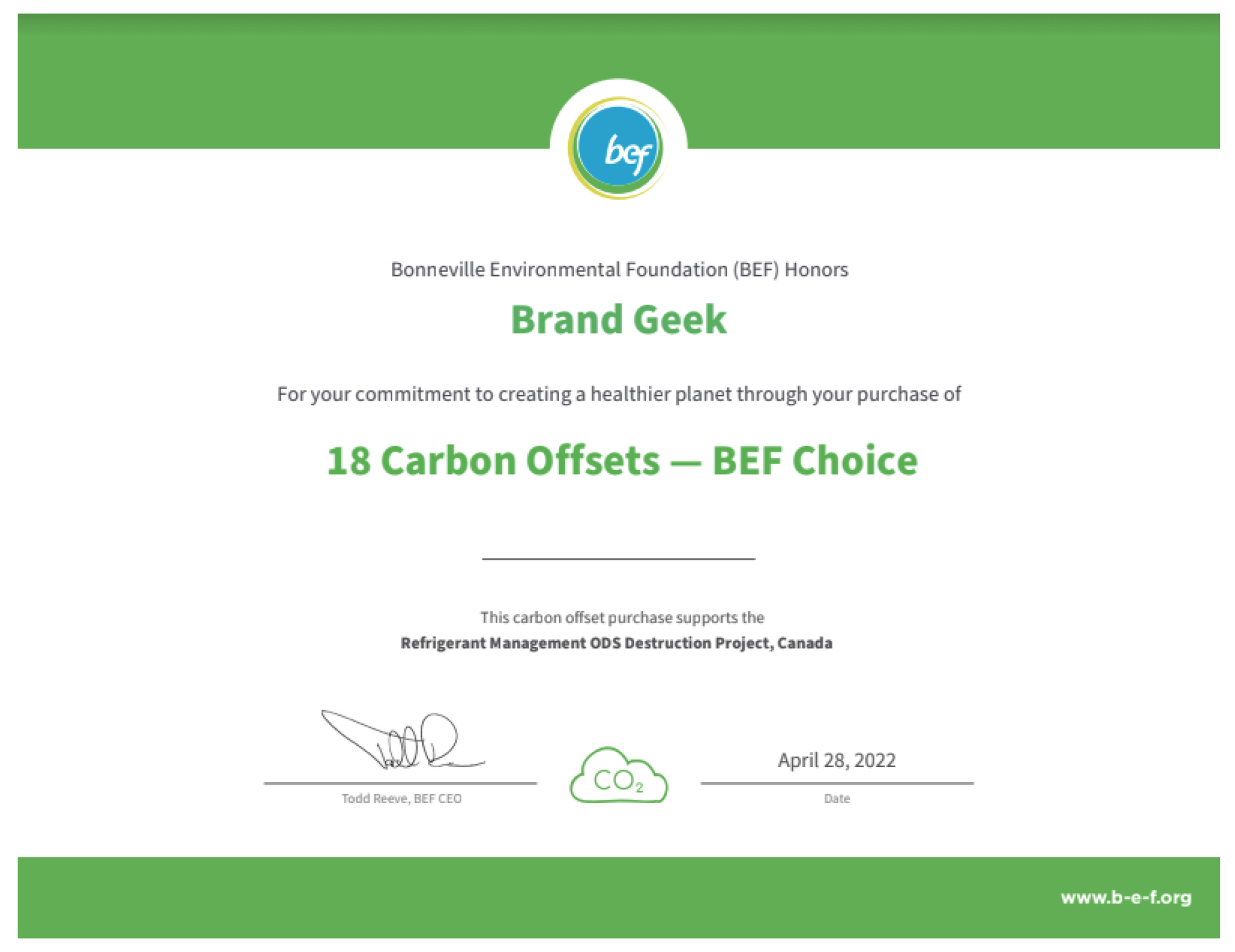Brandgeek proudly supports Mountain Area Preservation and is humbled to be…
NAD Teaches TransFair USA to fine tune Fair Trade Seals & Asks Avon to Amend Advertising
As discussed in my December 13, 2010 post, the National Advertising Division (NAD) of the Council of Better Business Bureaus (BBBs) offers a streamlined, self-regulatory mechanism for remedying false advertising claims made in nationally distributed advertisements. While NAD has a 95% success rate, those advertisers who fail to follow NAD’s recommendations may find themselves before the FTC upon NAD’s recommendation.
On February 16, 2011, I reported on NAD’s recommendation that Nano-Tex cease making several (green and other) advertising claims in connection with three of its fabric coating products. On January 24, 2011, I discussed NAD’s recommendation that Sherwin-Williams modify its no-VOC claims for its HARMONY brand paints. On June 8, 2011, NAD issued its latest press release regarding a claim brought by Dr. Bronner’s against TransFair USA and Avon:
[framed_box]The National Advertising Division of the Council of Better Business Bureaus has recommended that TransFair USA, which licenses use of “fair trade” seals, modify the authorized language that accompanies seals provided for personal-care products to make clear that such products may contain only 2-5% fair-trade certified ingredients. The organization has agreed to do so.[/framed_box]This case resulted from a challenge made by Dr. Bronner’s Magic Soaps, whose products are fair trade certified by the Institute for Marketcology (IMO), rather than by TransFair. (It’s daunting to keep the numerous fair trade organizations straight; the most comprehensive list I found is on the NGO Fair Trade Federation’s website.) Dr. Bronner’s and Avon are competitors in the personal care products space and Dr. Bronner’s challenged Avon’s use of TransFair’s seals on Avon’s “mark.” brand product line.
NAD reviewed the following express claims:
[framed_box]“Fair Trade Certified”
“Fair Trade Product of the Week”
“… excited to announce that “mark.’s” latest line of body products now proudly bears the Fair Trade Certified Label.”
“By choosing this Fair Trade Certified product, you are directly supporting a better life for farming families through fair prices, direct trade, community development, and environmental stewardship.”
“Fair Trade Certification means our collection helps farmers around the globe help themselves by investing in their farms and communities, encouraging the development of business skills and mandating environmentally sustainable farming methods. After all, what’s fair is fair.”
[/framed_box]and these implied claims:
[framed_box]All of the ingredients in Avon Products’ “mark.” body product line are Fair Trade Certified.
Consumers who purchase the “mark.” line of body products are supporting “Fair Trade.”
[/framed_box]TransFair licenses its FAIR TRADE CERTIFIED certification mark (also referred to as a “seal”) for products in which “[a]ll ingredients that can be fair trade certified are fair trade certified, the fair trade certified ingredient(s) constitutes more than 50% of the dry weight (excluding water) of the product, and, no formulation exemption has been issued.” TranFair also has two “Fair Trade Certified” seals for products (personal care and otherwise) that are made with only some (not all) fair-trade certified ingredients:
[framed_box]“Fair Trade Certified Ingredient-Specific” (for products with a single fair-trade certified ingredient) or
“Fair Trade Certified Ingredients” (for products with more than one fair-trade certified ingredient).
[/framed_box]The issue in this case is the message conveyed by the term “fair trade.” No other tribunal (specifically — no state or federal court, the FTC, or NAD) has opined on this issue before, making this a “case of first impression.”
Dr. Bronner’s took issue with the similarity in appearance of TransFair’s three Fair Trade logos:
[framed_box]Fair Trade Certified,
Fair Trade Certified Ingredients, and
Fair Trade Certified Ingredient-Specific
[/framed_box]and the allegedly similar manner in which products certified under each category are marketed. Dr. Bronner’s claimed that TransFair and Avon collectively market Avon’s entire “mark.” product line as “Fair Trade Certified,” even though the products in Avon’s “mark.” product line are comprised of minimal (2-5%) fair trade ingredients. Under TransFair’s Fair Trade Certified Cosmetics and Personal Care Products Formulation Policy the following thresholds must be met: 1.) for “leave on” oil/wax based products a minimum of 5% of the ingredients must be Fair Trade; and 2.) for “wash off” surfactant based products a minimum 2% of the ingredients must be Fair Trade.
Although it disagreed with Dr. Bronner’s claims, TransFair removed all references to Avon from its website, which it claimed rendered most of Dr. Bronner’s claims moot. TransFair argued that NAD did not have jurisdiction over Dr. Bronner’s remaining claims since its “Fair Trade Certified,” “Fair Trade Certified Ingredient-Specific,” and “Fair Trade Certified Ingredients” marks indicate that a licensee’s product meets TransFair’s certification standards, rather than marketing TransFair’s services. In the alternative, TransFair claimed that its Label and Language Use Guide distinguishes between the three categories of Fair Trade Certified, eliminating any chance of deception.
NAD issued separate orders against Avon and TransFair.
TransFair
NAD made clear that TransFair’s certification process and fair trade standards were not at issue in this case. It concluded that TransFair’s Fair Trade seals meet the definition of national advertising and, in accordance with NAD’s previous decisions, it has jurisdiction over cases involving the use of such seals/certification marks.
NAD found TransFair’s three seals to be similar, but not identical. Further, because TransFair’s personal care products policy requires clear identification of the fair trade certified ingredients in the ingredient list, and especially on the front panel of the product packaging, correct use of the seals prevents consumers from erroneously believing such products to be comprised entirely of fair trade certified ingredients.
However, NAD also found that TransFair’s “authorized statements” convey inaccurate messages about the amount of fair trade ingredients in personal care products. Specifically, NAD recommended that TransFair modify the challenged authorized statements:
[framed_box]. . . so that it is clear to consumers that: 1) the seal represents fair trade certification of ingredients, or that the product is made using some “Fair Trade Certified Ingredients”; and 2) personal care products need only contain 2-5% fair trade certified ingredients in order to bear one of the two composite product seals [/framed_box]Avon
NAD found the text used on Avon’s packaging in connection with the TransFair fair trade seals to be acceptable because it made clear that the product was made with only some fair trade ingredients. However, based on the evidence presented, NAD found Avon’s print and electronic advertising (including some photographic imagery) to over-emphasize fair trade certification and it therefore instructed Avon to discontinue its use of photographs of fair trade farm workers and statements like “help change the world with four of the best body care products on earth.”
Advertisers’ Statements
Both TransFair and Avon agreed to heed NAD’s recommendations. TransFair stated that, “[a]s part of its ongoing review process, Transfair it intends to follow the recommendations of NAD in order to further strengthen the Transfair personal care products policy.” Avon expressed disappointment with NAD’s findings regarding its use of certain photographs and messaging in print and internet advertisements, but stated that, ” . . . as a strong supporter of the self-regulatory process, it will take NAD’s recommendations into consideration in future advertising.”
 The proposed FTC Green Guides have an entire section on seals and certifications, filling a gap left by the current Green Guides. Anticipating the issuance of revised Guides in early 2012, certification mark owners should familiarize themselves with the Guides and be sure to work with counsel who understands them as well.
The proposed FTC Green Guides have an entire section on seals and certifications, filling a gap left by the current Green Guides. Anticipating the issuance of revised Guides in early 2012, certification mark owners should familiarize themselves with the Guides and be sure to work with counsel who understands them as well.






This Post Has 0 Comments